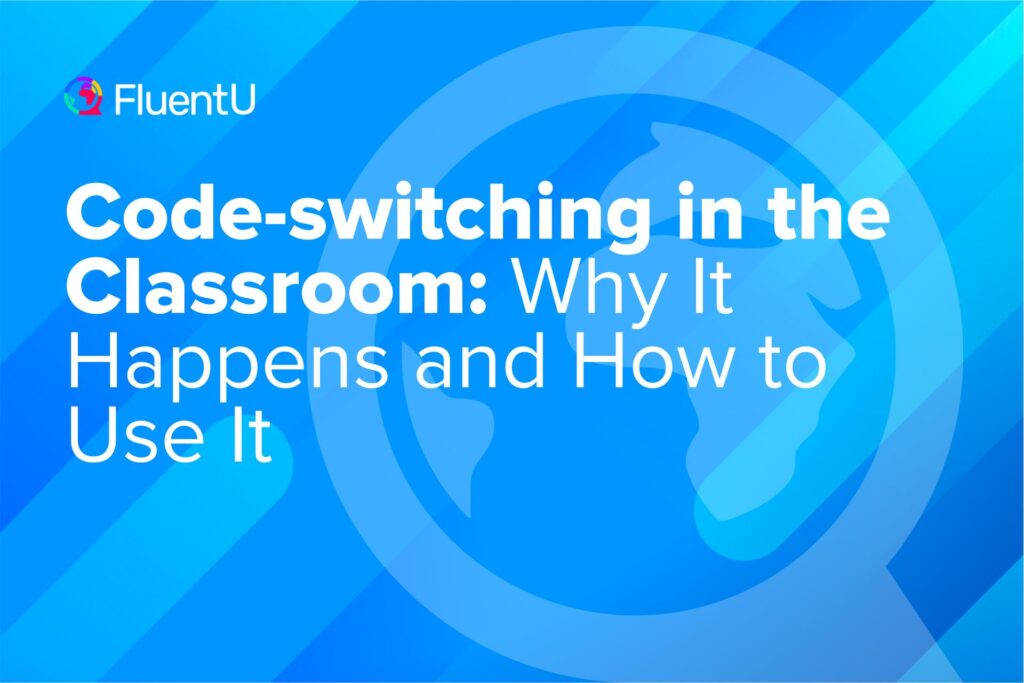Contents
- Why Language Teachers Code-switch
- Why Students Code-switch
- How to Use Code-switching to Your Advantage
- Be clear about when code-switching is and isn’t allowed
- Allow code-switching when conversation in the target language gets difficult
- Use code-switching to help students feel encouraged and supported
- Avoid repeating instructions in the native language after explaining them in the target language
- Be wary of code-switching in classrooms where students have different native languages
- Alternatives to Code-switching
Code-switching in the Classroom: Why It Happens and How to Use It

When you’re pursuing the sacred goal of language immersion in the classroom, slipping into a language other than the target one feels sacrilegious. But is code-switching really all it’s cracked up to be? The answer is complex.
In this post, I’ll discuss some of the motivations behind it for both teachers and students (spoiler alert: it’s not always just laziness). Then, I’ll tackle instances where code-switching can actually be helpful and situations where it should be avoided—plus alternatives to keep your class in immersion mode.
Download: This blog post is available as a convenient and portable PDF that you can take anywhere. Click here to get a copy. (Download)
Why Language Teachers Code-switch
Research on the topic shows that these are the most common reasons teachers code-switch.
- To address complex topics: Many language teachers might briefly switch to their students’ native language to better explain topics such as grammar—especially when the target language uses concepts that may not be present in the native language like gendered articles.
- To build rapport: As you know, students learn better in a warm and supportive environment, especially with potentially nerve-wracking subjects like foreign languages. Students just feel more comfortable when they’re addressed in their native language, and code-switching makes it easier to build positive relationships with them.
- To further clarify instructions: In a classroom environment where you only have an hour or so to teach, you want to make sure students clearly and quickly understand everything being communicated to them. Often, the most efficient way to accomplish this is by reverting to their native language.
Why Students Code-switch
Although it’s inevitable, student code-switching can be problematic depending on why it happens. Here are the most common reasons students code-switch.
- To fill gaps in a conversation: It’s human nature to feel awkward when there’s a lull in conversation, and those lulls are inevitable when communicating in a foreign language. Students often fall back on their native tongue to fill the silence.
- To clarify their message: Many students aren’t sure if they’ve expressed themselves clearly enough in the target language. Often, they’ll repeat or add to a response or question in their native language to make sure they’re understood.
- To compensate for a lack of competence: This is arguably the most common reason for student code-switching: they simply lack the knowledge and skill to express their thoughts in the target language effectively.
How to Use Code-switching to Your Advantage
Given the reasons above, it’s no surprise that code-switching often happens in the classroom—whether it’s the teacher doing it or the students.
When done in excess, however, code-switching can disincentivize students from communicating as much as possible in the target language. After all, if their teacher can comfortably talk to them in their native tongue anyway, why should they bother using the target language at all?
But, if used with care and intention, code-switching has the potential to become another useful tool in your repertoire.
Here are a few things you can do to manage that delicate balance between code-switching and not code-switching.
Be clear about when code-switching is and isn’t allowed
It wouldn’t be entirely realistic to embrace a “Target Language Only” or “100% Target Language Zone” policy in the classroom. Code-switching often happens subconsciously, so it’d be unfair to both you and your students to enforce consequences just because someone accidentally dropped one word in their native language one time.
Instead, it’d be better to set concrete boundaries around classroom code-switching. This will help you use it effectively and prevent confusion or sloppiness among your students.
Allow code-switching when conversation in the target language gets difficult
Going off of the last point, this is one instance where code-switching can help rather than hinder.
Using code-switching to bridge familiar and unfamiliar vocabulary can help students become more comfortable conversing spontaneously in the target language.
For example, if students can’t remember one word, you can allow them to substitute it with the word in their native language in order to continue the conversation. Otherwise, they may get so hung up on that one word that they lose the flow of their overall message.
Afterward, teach or review the missing word and discuss target language synonyms or explanations the student might’ve used to get their point across without code-switching.
You could also allow filler words (such as “well,” “like,” etc.) because this can help students feel more relaxed when they’re struggling to find just the right words.
Use code-switching to help students feel encouraged and supported
I’ve mentioned earlier that code-switching can help you build rapport with your students, owing to the comforting familiarity of the native language.
For example, you’ll occasionally want to explain to students in detail where they’re excelling. Depending on their comprehension level, this may require using their native language—which can in turn make them feel more recognized and connected to you. Otherwise, I recommend administering lots of simple praise in the target language.
If you notice that students are upset about something, use their native language to find out what’s wrong and to see if you can help. It’s easier for them to learn when they feel personally cared for!
Avoid repeating instructions in the native language after explaining them in the target language
As I’ve said earlier, reverting to code-switching is tempting, especially when there are only a handful of minutes left until the lesson ends.
However, repeating directions in the native language encourages bad habits. Why should students try to understand target language directions if they know that these are simply going to be repeated?
Be wary of code-switching in classrooms where students have different native languages
If all your students are native English speakers or can understand English, occasional code-switching may be helpful.
But if a good number are exchange students or immigrants, shifting between different target languages will be prohibitively confusing.
Alternatives to Code-switching
You’ve seen that code-switching has its merits. But, as with anything, it should be done in moderation. Besides, you want to shoot for as much immersion in the target language as possible.
So what can you do instead of code-switching? Here are some ideas.
Pre-teach vocabulary thoroughly
Go over new vocabulary before lessons, readings and the like by writing phrases on the board. Incorporate gestures and visual aids to make your meaning clear without falling back on the native language.
When your students encounter the new vocabulary beforehand, they’ll learn and absorb it more efficiently in the context of a learning task.
Provide plenty of comprehensible input
Use the target language consistently so students find it easy to understand and absorb new words. The more they hear the language, the more students will feel confident about reproducing it.
An easy way to achieve this in your classroom is to surround your students with the target language through posters, signs, books, magazines and audio recordings.
Innovative tools like FluentU can also be very helpful for this purpose. FluentU videos comes with interactive captions students can click to get an instant definition of any word they don’t recognize. They’ll also hear the word pronounced and see other videos the word is used in. Then they’ll get flashcards and exercises based on the video to make sure they retain the new words.
It’s a great way for students to practice listening comprehension and expand their vocabulary, all while gaining valuable exposure to the target language as it’s used in real life.
Make use of cognates
These helpful words are a language learner’s best friend! Cognates help make the language more comprehensible and boost student confidence.
Foster a supportive classroom environment
Above all, it’s important that students aren’t afraid to make mistakes in the target language.
Get to know your students and show you care about them. This will ensure that they make the effort to communicate in the target language even when they’re nervous.
Remember that when it comes to conversing, you don’t have to correct every mistake. It’s more important that your students get used to communicating in the target language as much as possible even if their grammar and word usage are off.
Is code-switching ideal? No, not really—but neither is it the face of evil. As teachers, we all want to aim for classroom immersion as much as possible.
Like any other tool, code-switching shouldn’t be a crutch. Instead, it should be just another item in an already full toolbox.
Download: This blog post is available as a convenient and portable PDF that you can take anywhere. Click here to get a copy. (Download)







